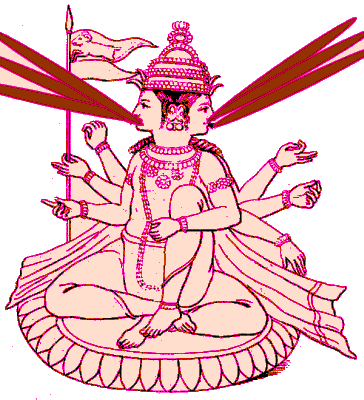|
|
|
AGNI

Image from Moor
Basic Description: The Devourer, the Vedic god of sun and fire. Agni was satisfied through sacrifice to bring prosperity for the Ayran tribe. Agni is considered the Outer Expression of the Cosmic Whole, the bahiscara—the outer impulse. Devouring and being devoured is the transformation of life, the very essence of the universe in Vedic philosophy. All of the universe is said to be made of fire (agni) and offering (soma). He is the enjoyer, the digester, the consumer: sun, heat, stomach, lust, and passion. The nature of Agni is to spread, to take over and rule. Alternate Names: None History/Practices: The Aryan God of Fire, Agni, was regarded as the protector of the men and of their homes. The common hearth of the Aryan tribe was the central fireplace. This is where Agni was lit and preserved by the Agni-hotras. Agni-hotras are also known as preservers of fire. This practice soon became known as Yagna, which means fire sacrifice. In later times, Agni's worship fell off dramatically and he has often become an incarnation of either Shiva or Brahma. Alternatively, he may be called on by lovers to increase virility. When people use fire, they must face it toward the proper direction for different uses. East—the fire should be used for sacrifices to the gods; South—the fire should be used for sacrifices to the Manes or spirits of the dead; West—a cooking fire. The proper offering to Agni, and hence all the gods, is ghee, which is clarified butter. Iconography: Usually pictured with two heads. He has seven tongues of fire and his teeth are sharp and golden. Sometimes he is shown covered in butter. Mythology: Agni is the god of fire who guards people and homes from evil. He is the vital spark in the earth; lightning in the sky; and Surya the sun. He is the sap in the plants, which is carried down to them by the rain. He is present in the dry sticks. By the friction he can be brought to birth from them, soaring to heaven. He brings fire down to earth as the lightning. He is electricity itself. Fire has seven parts and each part can be divided seven times and therefore gives fires that are spoken of in Hindu mythology. There are many descriptive passages of Agni and they describe him as raging in the forest like a lion whose golden mane flies in the wind. Agni is often closely associated with the god Indra , sometimes considered his twin brother. In a third account of the origin of the universe, Agni is considered part of a creating triad—Agni, Martus and Indra. Additionally, in the Purusha Sukta hymn, it is said that the gods performed a sacrifice with a giant’s body which became the earth. From his mouth sprang both Indra and Agni. In one version of a myth, Agni, in the form of the dove, took from Mahadeva, the seed of Kartikeya and let him fall into the river, emerging as a beautiful boy—Kartikeya became known as the son of Agni without a mother. Agni is also an important mediator between humans and gods. He consumes sacrifices and in this way is the pathway for the offerings. Agni also had the power to impart immortality on mortals, as well as remove all sins at the time of one's death. Riding Animal: A Ram. He is sometimes pictured riding on a chariot that is pulled by parrots or goats. Consort: Svaha SourcesDanliélou, Alain. The Myths and Gods of India. Rochester, Vermont: Inner Traditions International, 1991.Thomas, P. Epics, Myths and Legends of India. Bombay, India: D. B. Taraporevala Sons & Co. Private Ltd, 1961.
|
|



